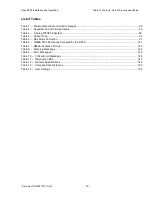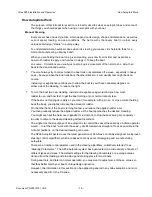
How Autopilots Work
Sitex SP38 Installation and Operation
Document PN
29010101
V2r0
- 1
8
-
The final part of the picture is the Steering System. In order for the autopilot to steer the boat,
there must be a steering system capable of moving the rudder independently of the ship’s
helm. This might be a hydraulic ram that is connected to the rudder post or tiller quadrant, or
an electric motor connected to the steering cables.
However, no matter what type of steering system the boat uses, electronic signals from the
SPU tell the system to move the rudder, when needed – how far and in which direction.
Your autopilot also have a Rudder Follower Unit (also called a Rudder Feedback Unit, or just
“RFU”), a device that tells the SPU what position the rudder is in at any given time.
Autopilot Operation
Maintaining a Heading: AUTO Mode
With a
Sitex
Autopilot, following a Track or Course that you want to be on is very simple:
•
Set the autopilot into
AUTO
mode.
•
Using the Control Head, input the Heading you want the autopilot to follow.
•
The autopilot then moves the rudder (as required) to initiate and keep the
vessel on that Heading … just like you would if you were steering
manually.
Here’s how it works:
The steering control algorithms running in the firmware on the SPU’s microcomputer are
constantly comparing – multiple times per second – the boat’s actual Heading (as indicated
by the Compass) to the desired Heading you have input.
If there is a difference, the algorithms then calculate how much to move the rudder, to
bring the boat back onto the desired Heading. The amount of corrective rudder movement
is based on:
•
How much the Headings differ.
•
How long there has been a difference and by how much.
•
How rapidly the difference is changing.
Here is an example which illustrates how the autopilot maintains a Heading in
AUTO
mode.
Imagine the boat is a few degrees off-course to Port:
•
The SPU will signal the steering system to move the rudder to Starboard,
by a few degrees.
How many degrees the rudder moves depends on the type of vessel, and
its dynamics (which you have specified and tested when you set up the
autopilot).
Note
: On a
SP38
Autopilot with an RFU, the SPU verifies that the rudder
has moved, by reading its position from the RFU.
•
The boat begins to turn to Starboard.
•
As the boat turns, the difference between the desired and actual
Heading
gets smaller, and as it does, the SPU then starts to ‘back off”
the rudder
– i.e., move it back to centre – so that the boat does not
overshoot the
desired Heading.
Summary of Contents for SP38 Autopilot
Page 2: ......
Page 14: ...Sitex SP38 Installation and Operation Document PN 29010101 V2r0 13 ...
Page 15: ...Sitex SP38 Installation and Operation Document PN 29010101 V2r0 14 Introduction ...
Page 16: ...Sitex SP38 Installation and Operation Document PN 29010101 V2r0 15 ...
Page 26: ...Sitex SP38 Installation and Operation Document PN 29010101 V2r0 25 ...
Page 35: ...Sitex SP38 Installation and Operation Document PN 29010101 V2r0 34 Installation ...
Page 36: ...Sitex SP38 Installation and Operation Document PN 29010101 V2r0 35 ...
Page 74: ...Sitex SP38 Installation and Operation Document PN 29010101 V2r0 73 ...
Page 108: ...Sitex SP38 Installation and Operation Document PN 29010101 V2r0 107 ...
Page 109: ...Sitex SP38 Installation and Operation Document PN 29010101 V2r0 108 Advanced Operations ...
Page 110: ...Sitex SP38 Installation and Operation Document PN 29010101 V2r0 109 ...
Page 123: ...Sitex SP38 Installation and Operation Document PN 29010101 V2r0 122 Care and Maintenance ...
Page 124: ...Sitex SP38 Installation and Operation Document PN 29010101 V2r0 123 ...
Page 127: ...Sitex SP38 Installation and Operation Document PN 29010101 V2r0 126 Appendices ...
Page 128: ...Sitex SP38 Installation and Operation Document PN 29010101 V2r0 127 ...
Page 156: ...Sitex SP38 Installation and Operation Document PN 29010101 V2r0 155 Warranty ...
Page 157: ...Sitex SP38 Installation and Operation Document PN 29010101 V2r0 156 User Notes and Settings ...
Page 158: ...Sitex SP38 Installation and Operation Document PN 29010101 V2r0 157 ...
















































